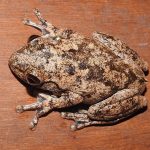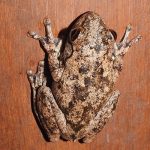ROTH'S TREE FROG
Roth’s tree frog is a small to medium-sized frog, typically measuring between 4 to 5 centimetres in length. It boasts a vibrant green to brown back, often with darker spots or mottling, which helps it blend seamlessly into its leafy surroundings. Its underbelly is a pale cream or white, providing a striking contrast. They have a remarkable ability to change colour, adapting to their surroundings to avoid predators. Typically, they are grey during the day whilst basking in the sun, and are brown at night. The frog’s large, expressive eyes are a golden hue, perfect for spotting prey in low light.
This species is primarily found in northern Australia, extending from the Kimberley region in Western Australia across the Northern Territory and into Queensland. Roth’s tree frog thrives in a variety of habitats, including tropical woodlands, savannas, and even urban areas. They are particularly fond of environments near water bodies like streams, ponds, and swamps. They are excellent climbers, thanks to the adhesive pads on their fingers and toes, which allow them to navigate the trees with ease.
Roth’s tree frog is an opportunistic feeder, dining on a diet of insects and other small invertebrates. Its diet mainly includes moths, beetles, and flies, which it catches with its quick, sticky tongue.
Breeding typically occurs during the wet season, when the frogs gather in large numbers near water sources. The males call out with a distinctive “wark-wark-wark” sound to attract females. Once paired, the female lays her eggs in water, where they hatch into tadpoles. These tadpoles undergo metamorphosis, transforming into adult frogs over several weeks.
In the wild, Roth’s tree frogs can live for several years, although exact lifespan data is limited.
Currently, Roth’s tree frog is listed as “Least Concern” by the International Union for Conservation of Nature (IUCN). This status indicates that, while their populations are stable, ongoing habitat preservation is crucial to ensure their continued survival.
The call of Roth’s tree frog is a distinctive, repetitive “wark-wark-wark,” which can be heard echoing through the night during the breeding season. This call is vital for attracting mates and establishing territory.
Roth’s tree frogs are not only an enchanting creature of the Australian landscape but also a critical component of its ecosystem. Understanding and appreciating such species encourages us to protect their natural habitats for future generations.


